Post by Thoithoi O'Cottage on Mar 2, 2014 19:46:56 GMT 5.5
Cinematics is the way cinematic means are employed in films. Cinematics, the study of cinematic properties in films, treats films as texts, and every film is thus a cinematic text.
Based on Leo Tolstoy’s finest and one of the world’s most beautiful novels ever of the same name, Anna Karenina (2012) is a stylistic film very carefully made—in color, costume, direction, editing, sound, music, lighting, production design, cinematography and so on. In this short post I would study the cinematic devices of editing and cinematography director Joe Wright uses in the horse race scene.
Count Karenin (Jude Law), a senior statesman, rightly senses that his wife Anna Karenina (Keira Knightley) has an affair with Count Vronsky (Aaron Taylor-Johnson), a cavalry officer. Now in the hedge maze in the garden of Karenin’s rented house Anna, at the end of playing hide-and-seek with her little son Serozha, abruptly tells her husband, more to avoid him sooner, that she has to go in and change because Princess Betsy is taking her to watch the horse race that evening. A clever woman, she casually asks her husband, to neutralize what her abrupt leave-taking has made tensed, if he would like to come. Her equally intelligent but more self-controlled husband says:
No, I’ll come on later, and then I must get back to town.
However, he arrives at the venue in time, though after most people have taken their seats. He knows Vronsky is going to be one of the racers and his wife’s interest is in him. He is determined to spy on his wife. Looking for a vantage, he stands in a rear row, smiling and raising his hat to acquaintances, but his eyes busy looking for his wife who is up at the Ladies’ Stand.
The race course is a “rough-and-ready” one, which is also the venue for a high society occasion, with a grand stand for top people and a grander section, ornamented for greater comfort, for members of the Imperial family. It is also a fashion parade for some. The course itself is an oval approached by a straight.
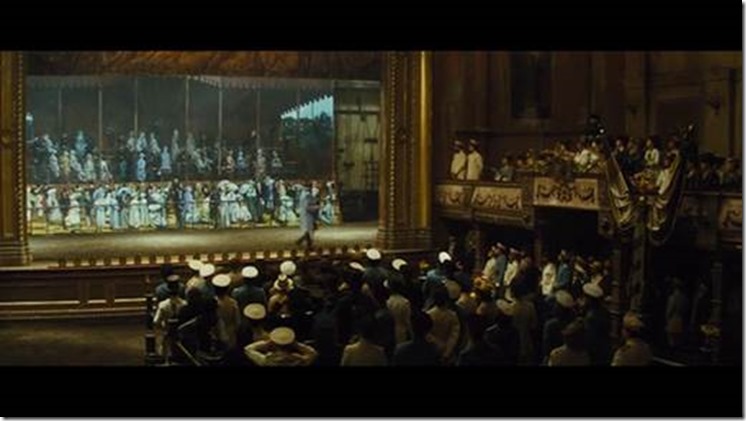
Figure 1. Race course view
With the rise of the curtain of the race course view, the hitherto dinning audience falls into silence anxiously in preparation for the view. The camera covers the whole audience in a wide angle from the front, and then pans left toward Anna across the Ladies’ Stand reading anxiety and excitement in their faces.
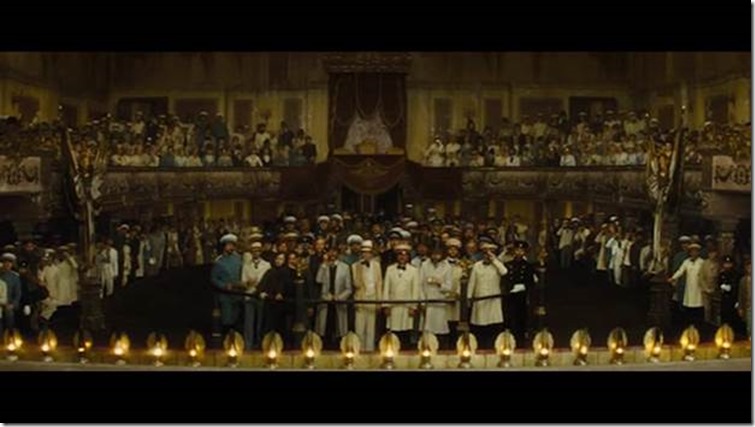
Figure 2. The audience
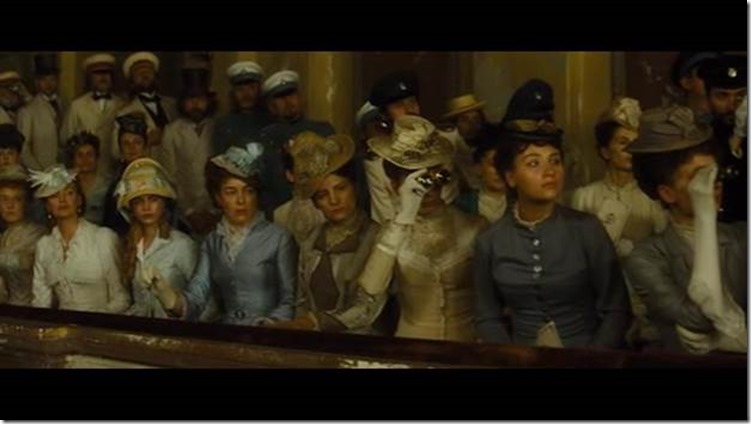
Figure 3. Excited audience
In the absolute silence we hear a sound which increasingly breathless and perhaps quite annoying as it gets louder. In the next shot showing the source of the funny sound the camera, which was panning in the previous shot, pushes in on to Anna fanning herself neurotically in a Russian evening. The only person in the audience to hold a fan, she is restless and anxious for Vronsky—she wants him to win the race.
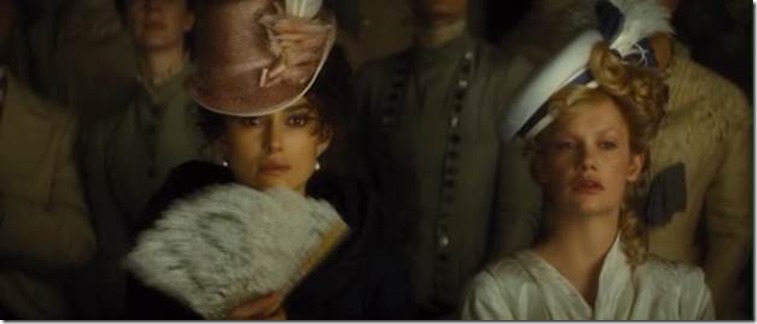
Figure 4. Restless Anna fanning
Count Karenin who is observing his wife through a short range binocular sees her fanning herself vigorously.

Figure 5. Count Karenin observing his wife
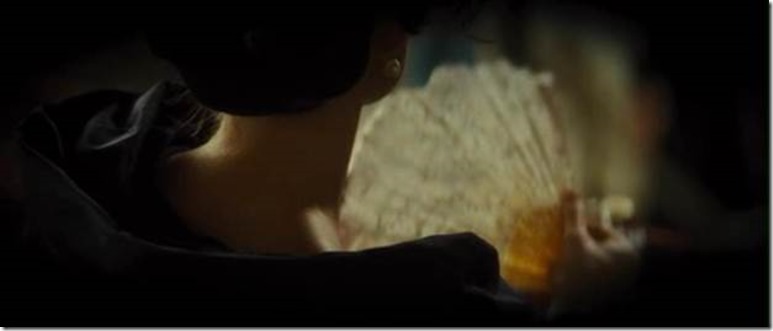
Figure 6. Karenin sees his wife restless for Vronsky
As the race approaches the sound of the fanning turns to or merges with the sounds of running hooves. Anna put her fan on the low desk before her, raises her binocular and sees Vronsky coming hopelessly almost about the tail of other racers. Karenin sees his wife’s left hand squeezing her folded fan unconsciously half-destroying it, as if desperately urging Vronsky to seed up.
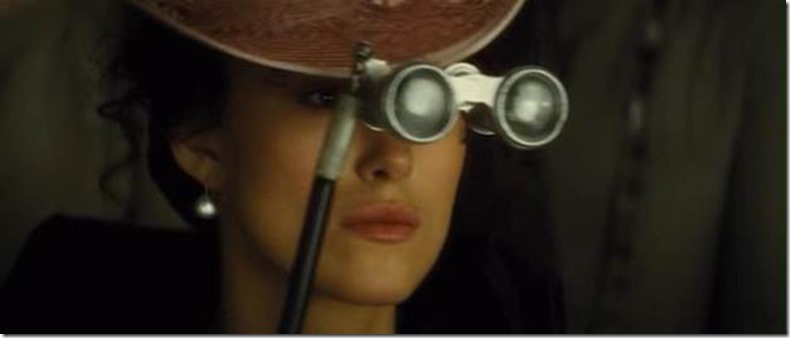
Figure 7. Anna holds up her binocular
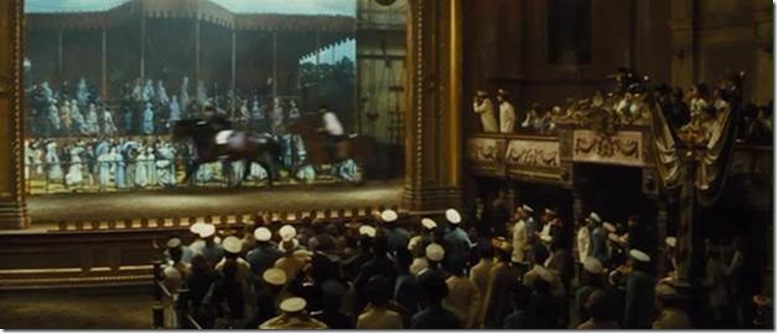

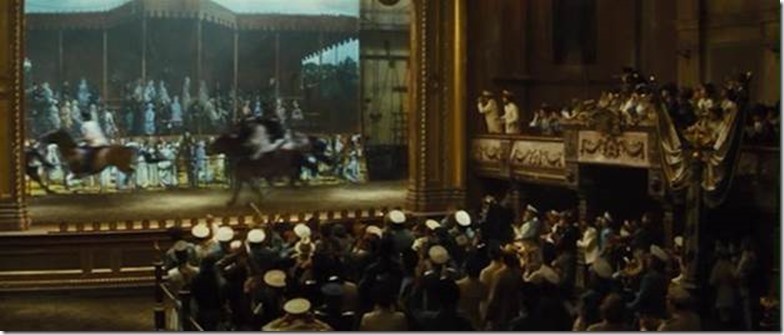
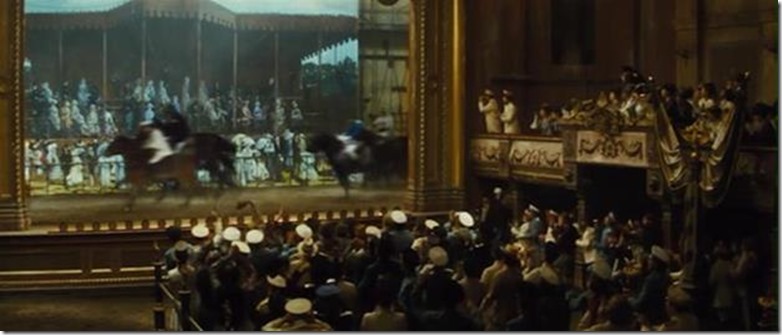
Figure 8. Vronsky comes almost at the tail of the race.

Figure 9. Anna desperately squeezing her fan
In the second lap Vronsky picks up speed, overtakes all other racers, and when they reach the view before the audience he clearly starts to overtake the only runner before him but all of a sudden his left stirrup snaps and his rein-pull sends his horse dangerously off the course and it collapses on the ground before the audience, breaking her own back and insuring him.
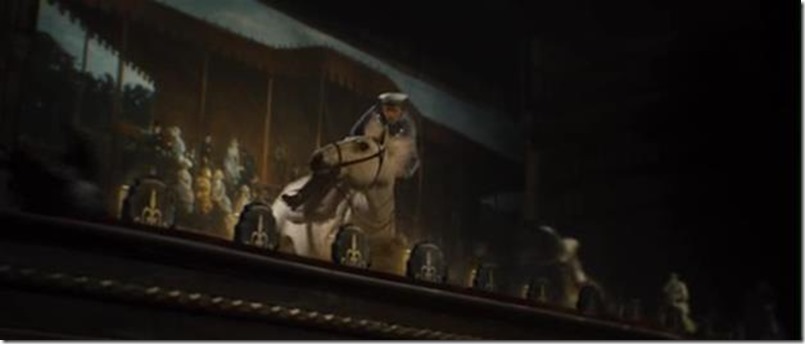
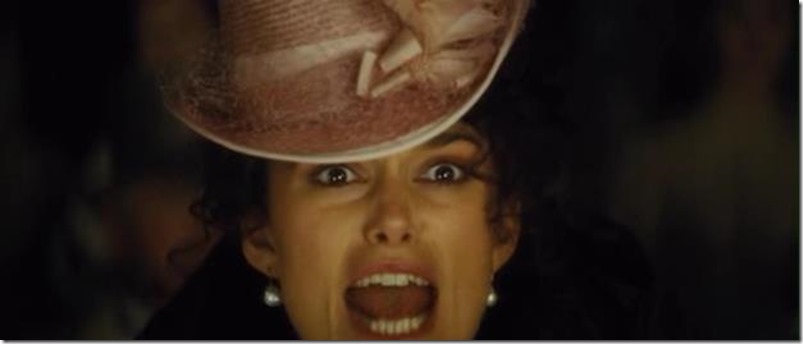
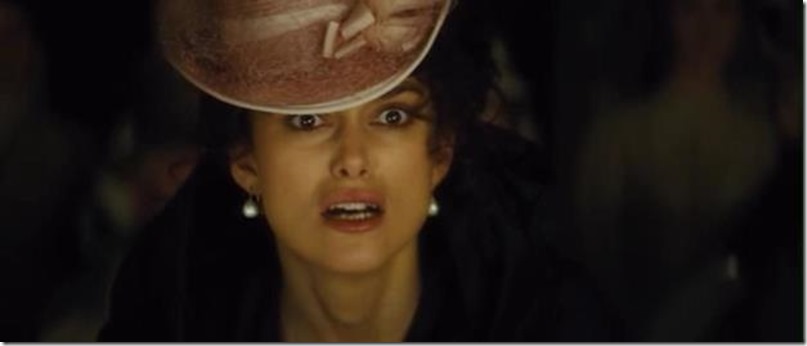
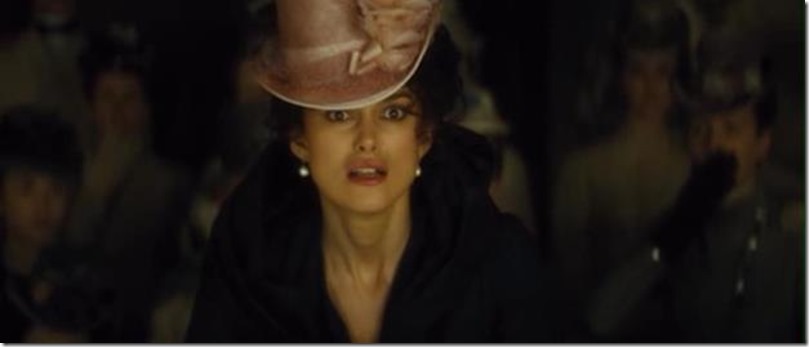
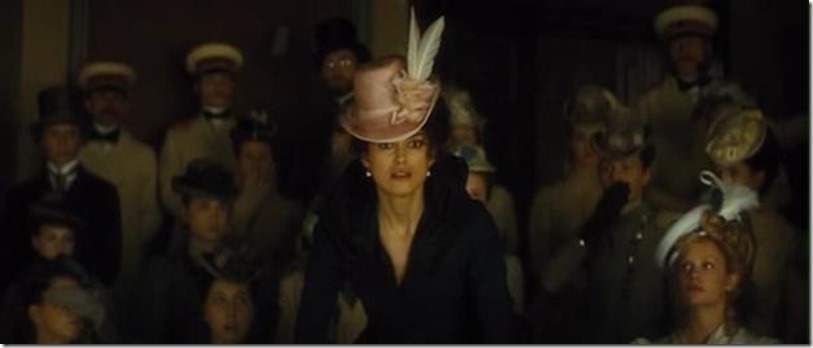

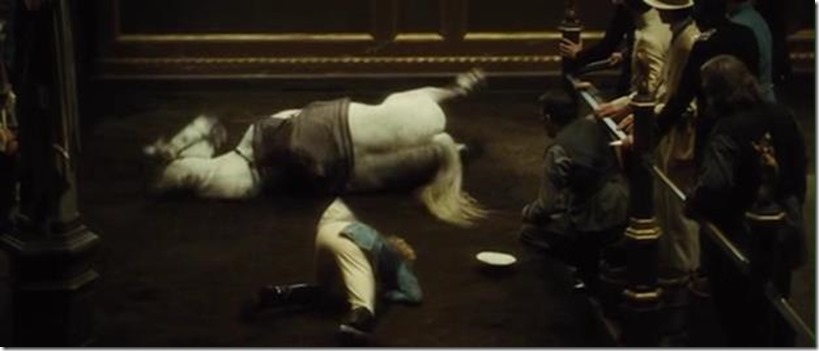
Terrifyingly worried Anna cries:
“Alexei!”
The name “Alexei” is very tricky here. Anna’s husband’s full name is Alexei Alexandrovich Karenin, and Vronsky’s is Alexei Kirillovich Vronsky. The two men’s names have “Alexei” in common—one is her husband and the other her lover with whose secret child she is pregnant now.
Socially respected Alexei Alexandrovich Karenin is very much concerned about what society may say and fears social disgrace. In many instances he presses this point on her. On the contrary, Anna is a passionate woman, and in love she does not care much about society, and thinks she can bear any degree of disgrace for love. And at many times she acts on the whim of a moment, without thinking. And her cry in this instance in the otherwise absolute silence of the hall holds up her husband in front of the so many people of dignity. To cinematically communicate Karenin’s embarrassment in this, Joe Wright frames Anna in tight close up when she sharply cries “Alexei!”, and from there he pulls the camera back to a long shot in order to locate her in the social context, with the rest of the people around looking at her, rather than at the accident scene, with her husband standing conspicuously in the background.
Her husband rushes to her–he wants to be this Alexei, the only Alexei, when he is well aware that he is only one of the Alexeis. “I’m here!” he says and pulls her back up. However, Anna has lost control, trying to escape like a bird beating against its cage. Embarrassed, Karenin looks about now and then repeats what he has said, “I’m here!”, trying to control her, bring her back to sense in vain. She picks up her half-destroyed fan and starts to fan herself more hysterically than before, with that irritating sound.

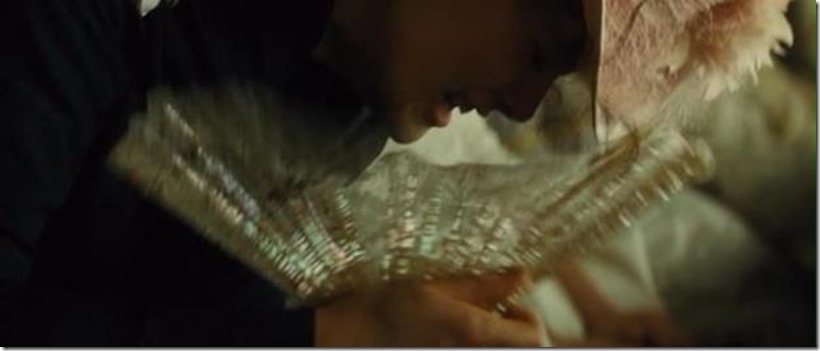
Figure 10. Anna fanning again hysterically
In front of the audience Vronsky extricates himself from his broken horse and in terrible recrimination tries to pull his struggling horse to her feet by the reins. A cavalry doctor restrains Vronsky, who says the horse’s back is broken. Hopeless Vronsky removes his pistol from his holster.
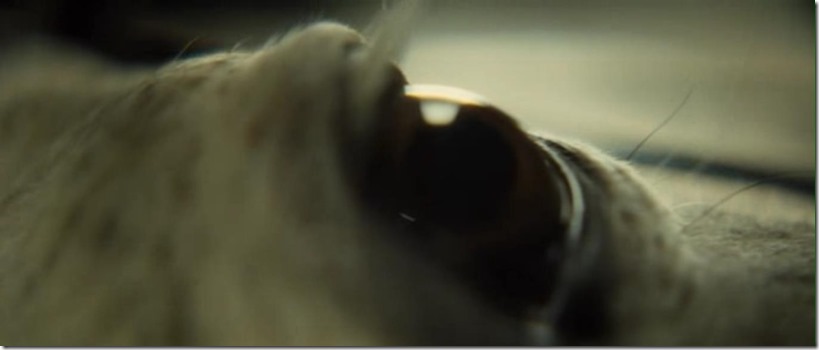
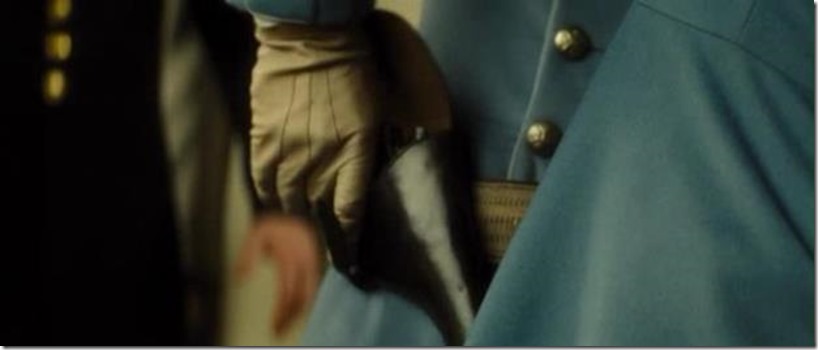
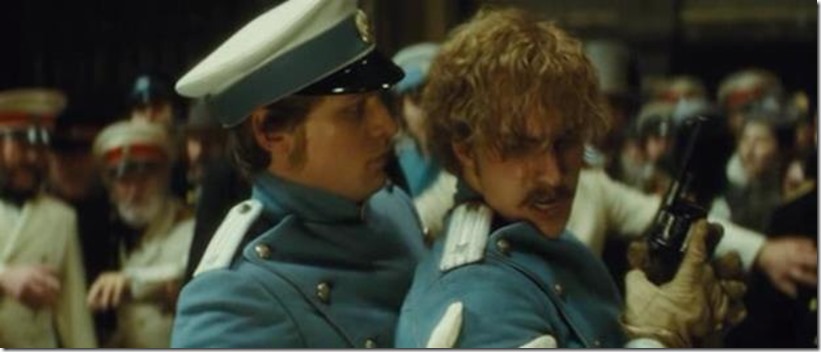
The shot is cut to the close-up of Anna shooting an angry tear-streaked look back at her husband trying to pacify her from behind. Then the shot is cut back to Vronsky shooting his horse. Cut together with the the close-up of now-hysterical Anna which is in right turn cut together with the medium close-up of her husband, Vronsky’s gunshot does not just kill the horse, it also serves Anna’s defiant purpose of emotionally shooting anything in the way of fulfilling her unrestrained passion.
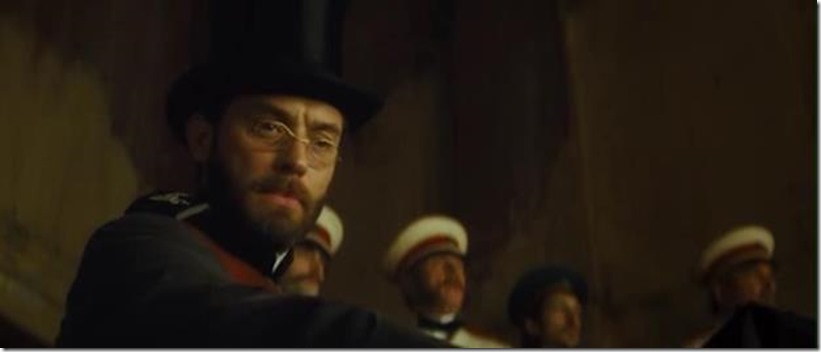
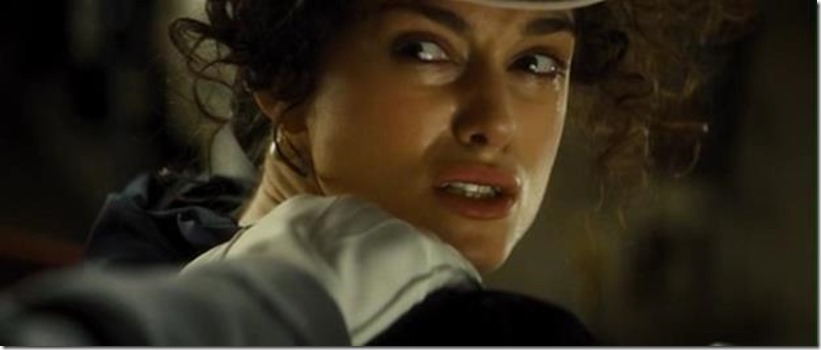
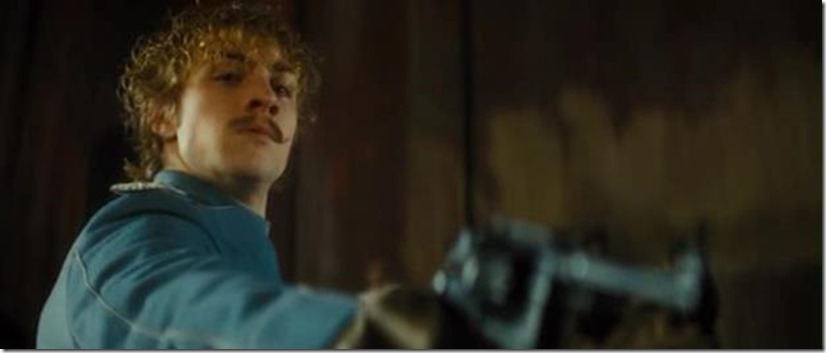
The next is of absolute silence. On their way back home Karenin and Anna sit in a coach in absolute silence each slightly turned away from the other. Then the clatter of hooves trickles in.
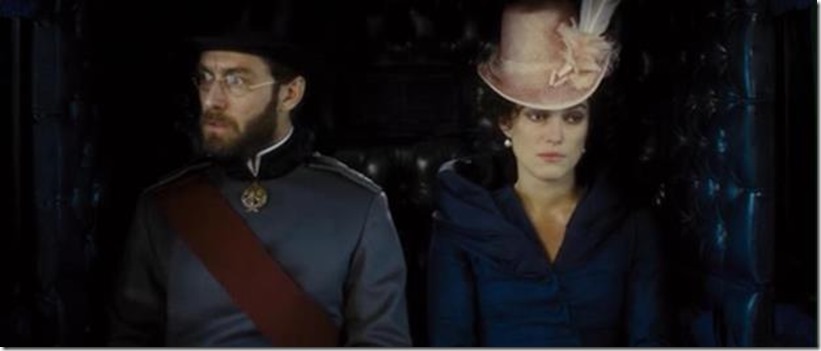
Figure 11. The couple silent in the coach
In fact very little linguistic sign or verbal exchange is used in the more than 3 minute long scene, though the scene, enlivened by the lively but indiscernible din of the people’s mutual greetings, and formal and casual social exchange and other familiar sounds such as of horse hooves, etc., does not sound lacking in spoken words. Wright cinematizes what a novelist or poet does with words, and with cinematic gestures he can cinematically communicate the nuances of the intricate relationship dynamics in the scene very much eloquently. Just as how words are used makes a novel eloquent, a film is made eloquent by its cinematics.
Based on Leo Tolstoy’s finest and one of the world’s most beautiful novels ever of the same name, Anna Karenina (2012) is a stylistic film very carefully made—in color, costume, direction, editing, sound, music, lighting, production design, cinematography and so on. In this short post I would study the cinematic devices of editing and cinematography director Joe Wright uses in the horse race scene.
Count Karenin (Jude Law), a senior statesman, rightly senses that his wife Anna Karenina (Keira Knightley) has an affair with Count Vronsky (Aaron Taylor-Johnson), a cavalry officer. Now in the hedge maze in the garden of Karenin’s rented house Anna, at the end of playing hide-and-seek with her little son Serozha, abruptly tells her husband, more to avoid him sooner, that she has to go in and change because Princess Betsy is taking her to watch the horse race that evening. A clever woman, she casually asks her husband, to neutralize what her abrupt leave-taking has made tensed, if he would like to come. Her equally intelligent but more self-controlled husband says:
No, I’ll come on later, and then I must get back to town.
However, he arrives at the venue in time, though after most people have taken their seats. He knows Vronsky is going to be one of the racers and his wife’s interest is in him. He is determined to spy on his wife. Looking for a vantage, he stands in a rear row, smiling and raising his hat to acquaintances, but his eyes busy looking for his wife who is up at the Ladies’ Stand.
The race course is a “rough-and-ready” one, which is also the venue for a high society occasion, with a grand stand for top people and a grander section, ornamented for greater comfort, for members of the Imperial family. It is also a fashion parade for some. The course itself is an oval approached by a straight.

Figure 1. Race course view
With the rise of the curtain of the race course view, the hitherto dinning audience falls into silence anxiously in preparation for the view. The camera covers the whole audience in a wide angle from the front, and then pans left toward Anna across the Ladies’ Stand reading anxiety and excitement in their faces.

Figure 2. The audience

Figure 3. Excited audience
In the absolute silence we hear a sound which increasingly breathless and perhaps quite annoying as it gets louder. In the next shot showing the source of the funny sound the camera, which was panning in the previous shot, pushes in on to Anna fanning herself neurotically in a Russian evening. The only person in the audience to hold a fan, she is restless and anxious for Vronsky—she wants him to win the race.

Figure 4. Restless Anna fanning
Count Karenin who is observing his wife through a short range binocular sees her fanning herself vigorously.

Figure 5. Count Karenin observing his wife

Figure 6. Karenin sees his wife restless for Vronsky
As the race approaches the sound of the fanning turns to or merges with the sounds of running hooves. Anna put her fan on the low desk before her, raises her binocular and sees Vronsky coming hopelessly almost about the tail of other racers. Karenin sees his wife’s left hand squeezing her folded fan unconsciously half-destroying it, as if desperately urging Vronsky to seed up.

Figure 7. Anna holds up her binocular




Figure 8. Vronsky comes almost at the tail of the race.

Figure 9. Anna desperately squeezing her fan
In the second lap Vronsky picks up speed, overtakes all other racers, and when they reach the view before the audience he clearly starts to overtake the only runner before him but all of a sudden his left stirrup snaps and his rein-pull sends his horse dangerously off the course and it collapses on the ground before the audience, breaking her own back and insuring him.







Terrifyingly worried Anna cries:
“Alexei!”
The name “Alexei” is very tricky here. Anna’s husband’s full name is Alexei Alexandrovich Karenin, and Vronsky’s is Alexei Kirillovich Vronsky. The two men’s names have “Alexei” in common—one is her husband and the other her lover with whose secret child she is pregnant now.
Socially respected Alexei Alexandrovich Karenin is very much concerned about what society may say and fears social disgrace. In many instances he presses this point on her. On the contrary, Anna is a passionate woman, and in love she does not care much about society, and thinks she can bear any degree of disgrace for love. And at many times she acts on the whim of a moment, without thinking. And her cry in this instance in the otherwise absolute silence of the hall holds up her husband in front of the so many people of dignity. To cinematically communicate Karenin’s embarrassment in this, Joe Wright frames Anna in tight close up when she sharply cries “Alexei!”, and from there he pulls the camera back to a long shot in order to locate her in the social context, with the rest of the people around looking at her, rather than at the accident scene, with her husband standing conspicuously in the background.
Her husband rushes to her–he wants to be this Alexei, the only Alexei, when he is well aware that he is only one of the Alexeis. “I’m here!” he says and pulls her back up. However, Anna has lost control, trying to escape like a bird beating against its cage. Embarrassed, Karenin looks about now and then repeats what he has said, “I’m here!”, trying to control her, bring her back to sense in vain. She picks up her half-destroyed fan and starts to fan herself more hysterically than before, with that irritating sound.


Figure 10. Anna fanning again hysterically
In front of the audience Vronsky extricates himself from his broken horse and in terrible recrimination tries to pull his struggling horse to her feet by the reins. A cavalry doctor restrains Vronsky, who says the horse’s back is broken. Hopeless Vronsky removes his pistol from his holster.



The shot is cut to the close-up of Anna shooting an angry tear-streaked look back at her husband trying to pacify her from behind. Then the shot is cut back to Vronsky shooting his horse. Cut together with the the close-up of now-hysterical Anna which is in right turn cut together with the medium close-up of her husband, Vronsky’s gunshot does not just kill the horse, it also serves Anna’s defiant purpose of emotionally shooting anything in the way of fulfilling her unrestrained passion.



The next is of absolute silence. On their way back home Karenin and Anna sit in a coach in absolute silence each slightly turned away from the other. Then the clatter of hooves trickles in.

Figure 11. The couple silent in the coach
In fact very little linguistic sign or verbal exchange is used in the more than 3 minute long scene, though the scene, enlivened by the lively but indiscernible din of the people’s mutual greetings, and formal and casual social exchange and other familiar sounds such as of horse hooves, etc., does not sound lacking in spoken words. Wright cinematizes what a novelist or poet does with words, and with cinematic gestures he can cinematically communicate the nuances of the intricate relationship dynamics in the scene very much eloquently. Just as how words are used makes a novel eloquent, a film is made eloquent by its cinematics.

